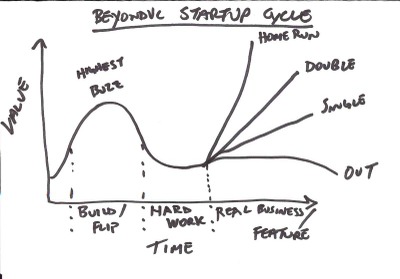I have made many posts in the past about focus and doing more with less, and as I continued on this path it reminded me of Occam's Razor, the idea that the simplest explanation to any problem is the best explanation. Of course Occam's Razor can get more complex but over the years it has been associated with the idea that "less is more." And when I apply this philosophy to the current state of venture, I can see many applications of this theory.
From a VC fund perspective, there has been much discussion about how venture funds have become too large to deliver outsized returns. First with the lack of an IPO market it is much harder to generate $1.5b for investors on a $500mm fund then it is to deliver $300mm on a $100mm fund. Secondly having too large a pool forces VCs to invest much larger amounts of capital into companies pushing up valuations and also exit hurdles for success. Finally, as I have written in the past, I have learned firsthand the problem of giving companies too much money too early. It can lead to a growth at all costs mentality, a lack of focus which means chasing too many opportunities at once, and a lax attitude on how to generate revenue. Enter Occam's Razor as it seems that the new trend is for smaller groups of GPs to form smaller funds to be able to invest in earlier stage companies. With the new operating model of capital efficiency, a little amount of money can go a long way and help VCs generate excellent returns at much lower valuations. Having a smaller fund allows VCs to write smaller checks and take advantage of the current market.
From an entrepreneur's perspective, Occam's Razor can be applied to many different avenues. As we all know, a great entrepreneur must be able to effectively allocate his scarce resources of time and money to fulfill a market need. The longer it takes to develop a product that the market wants means that it will cost more money and that it also opens the door for a competitor to step in before you. If you look at the current Internet and SAAS market, the idea of "release early and release often" certainly fulfills the Occam vision. Rather than spend cycles creating the perfect product with every bell and whistle, many nimble startups have focused on a more reductionist theory of releasing an often simpler product quickly with the idea of getting market feedback for the next iteration.
Occam's Razor also applies to how an entrepreneur should operate his business. Don't pursue too many markets at once, focus on what is delivering the most return for the dollars invested, and hire people and scale your business when you absolutely have a repeatable revenue model. I have been burned like many others by aggressively building out a sales team too early without a repeatable sales model. In addition, from a sales and marketing perspective, we have seen a movement to more of a frictionless sales model where there is less hands-on interaction with customers selling and delivering a product. This would include customers being able to go online and sign up for free trials or download software versus having an expensive direct sales force sell million dollar licenses and one month of professional services to install a product. Finally and most importantly, the idea of less is more certainly applies to raising capital. With the rise of open source software and cloud computing, companies can now get started with less dollars and scale more cheaply and efficiently than before. As all entrepreneurs know, raising less capital means retaining more ownership.
In summary, it is becoming increasingly clear that Occam's Razor and the idea of less is more will continue to spread as the cost of technology continues to decrease, as entrepreneurs get even more efficient in building businesses, and as a non-existent IPO market and the factors above lead more VCs to create smaller more nimble funds to capitalize on the new market realities.
